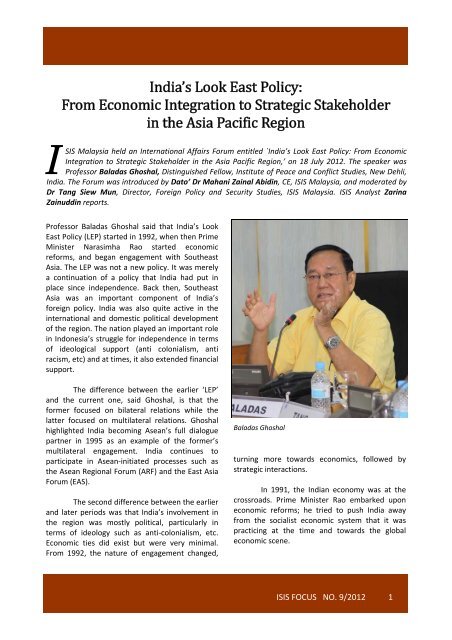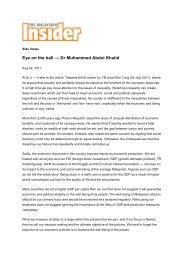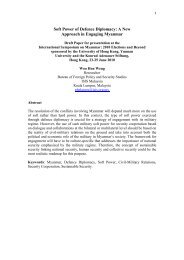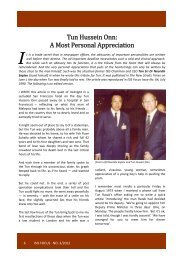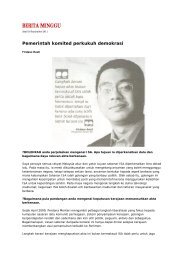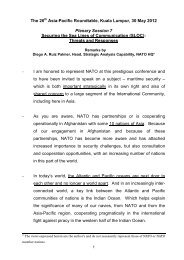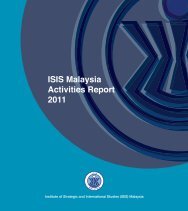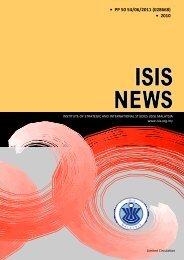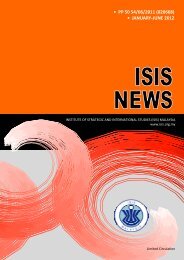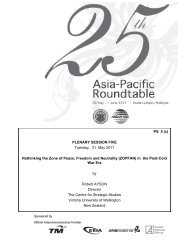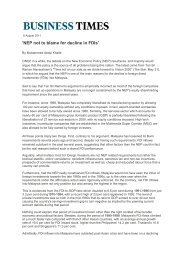India's Look East Policy - ISIS Malaysia
India's Look East Policy - ISIS Malaysia
India's Look East Policy - ISIS Malaysia
You also want an ePaper? Increase the reach of your titles
YUMPU automatically turns print PDFs into web optimized ePapers that Google loves.
India’s <strong>Look</strong> <strong>East</strong> <strong>Policy</strong>:<br />
From Economic Integration to Strategic Stakeholder<br />
in the Asia Pacific Region<br />
I<br />
SIS <strong>Malaysia</strong> held an International Affairs Forum entitled `India’s <strong>Look</strong> <strong>East</strong> <strong>Policy</strong>: From Economic<br />
Integration to Strategic Stakeholder in the Asia Pacific Region,’ on 18 July 2012. The speaker was<br />
Professor Baladas Ghoshal, Distinguished Fellow, Institute of Peace and Conflict Studies, New Dehli,<br />
India. The Forum was introduced by Dato’ Dr Mahani Zainal Abidin, CE, <strong>ISIS</strong> <strong>Malaysia</strong>, and moderated by<br />
Dr Tang Siew Mun, Director, Foreign <strong>Policy</strong> and Security Studies, <strong>ISIS</strong> <strong>Malaysia</strong>. <strong>ISIS</strong> Analyst Zarina<br />
Zainuddin reports.<br />
Professor Baladas Ghoshal said that India’s <strong>Look</strong><br />
<strong>East</strong> <strong>Policy</strong> (LEP) started in 1992, when then Prime<br />
Minister Narasimha Rao started economic<br />
reforms, and began engagement with Southeast<br />
Asia. The LEP was not a new policy. It was merely<br />
a continuation of a policy that India had put in<br />
place since independence. Back then, Southeast<br />
Asia was an important component of India’s<br />
foreign policy. India was also quite active in the<br />
international and domestic political development<br />
of the region. The nation played an important role<br />
in Indonesia’s struggle for independence in terms<br />
of ideological support (anti colonialism, anti<br />
racism, etc) and at times, it also extended financial<br />
support.<br />
The difference between the earlier ‘LEP’<br />
and the current one, said Ghoshal, is that the<br />
former focused on bilateral relations while the<br />
latter focused on multilateral relations. Ghoshal<br />
highlighted India becoming Asean’s full dialogue<br />
partner in 1995 as an example of the former’s<br />
multilateral engagement. India continues to<br />
participate in Asean‐initiated processes such as<br />
the Asean Regional Forum (ARF) and the <strong>East</strong> Asia<br />
Forum (EAS).<br />
The second difference between the earlier<br />
and later periods was that India’s involvement in<br />
the region was mostly political, particularly in<br />
terms of ideology such as anti‐colonialism, etc.<br />
Economic ties did exist but were very minimal.<br />
From 1992, the nature of engagement changed,<br />
Baladas Ghoshal<br />
turning more towards economics, followed by<br />
strategic interactions.<br />
In 1991, the Indian economy was at the<br />
crossroads. Prime Minister Rao embarked upon<br />
economic reforms; he tried to push India away<br />
from the socialist economic system that it was<br />
practicing at the time and towards the global<br />
economic scene.<br />
<strong>ISIS</strong> FOCUS NO. 9/2012 1
<strong>ISIS</strong> International Affairs Forum<br />
Why Southeast Asia Prime Minister Rao’s<br />
speech in 1994 in Singapore gave a clue —<br />
Southeast Asia could be a spring board for India’s<br />
entry into the global market. Southeast Asia was<br />
already part of the global economy and its<br />
economies were quite open. Besides, some of its<br />
economies, such as <strong>Malaysia</strong>, Thailand, etc, were<br />
being referred to as the tiger economies; many of<br />
these countries are considered models of<br />
economic development for other Third World<br />
countries.<br />
There is also a strategic content to India’s<br />
relations with Southeast Asia, although it was not<br />
stated clearly at the time. The strategic content<br />
was Myanmar or Burma. In 1988, India finding the<br />
Junta, the ruling regime in Myanmar despicable,<br />
and deploring the actions taken by the regime in<br />
repressing its citizens and elections, etc, chose to<br />
break contact with the nation.<br />
But by 1991‐92, India discovered that<br />
non‐engagement did not affect the regime’s way<br />
of doing things. India, in essence implementing an<br />
extension of US policy, had not brought about any<br />
major change in Myanmar’s military regime. By<br />
1992, India discovered that China had entrenched<br />
itself both economically and strategically in<br />
Myanmar. India realized that despite Myanmar’s<br />
despicable human rights record, it needed to<br />
engage and to do business with that nation.<br />
Ghoshal characterized 1992 to 2003 as the<br />
‘first phase’ of India’s LEP, 2003 to 2010 as the<br />
second phase and 2010 to the present as the<br />
third.<br />
The first phase involved India’s mainly<br />
economic engagement with Asean, through<br />
dialogue partnership, annual meetings, and<br />
through the ARF. Outside of the United Nations,<br />
Asean was the only organization that India<br />
engaged with. India gained experience in strategic<br />
as well as economic engagement. It learned to<br />
share its thoughts with the leaders of Southeast<br />
Asia. During this period, India’s engagement was<br />
fairly low‐profile. Economically, India did not gain<br />
much; there was a slight increase in trade.<br />
Strategically too, Ghoshal felt India was not much<br />
on the radar of Southeast Asia.<br />
In 2003, India signed the Treaty of Amity<br />
and Cooperation (TAC). TAC is a precondition for<br />
membership in the <strong>East</strong> Asian Summit. India was<br />
getting closer to Southeast Asia because as<br />
Ghoshal put it, ‘it almost became part of the club.’<br />
During this period, there was a shift from the<br />
political‐economic to the strategic, and a number<br />
of strategic agreements were signed with<br />
members of Asean — Indonesia, Thailand,<br />
Singapore and <strong>Malaysia</strong>.<br />
Another shift was that India expanded its<br />
area of engagement from Southeast Asia to <strong>East</strong><br />
Asia, specifically South Korea and Japan. Thus,<br />
India’s LEP was no longer only about Southeast<br />
Asia but also <strong>East</strong> Asia.<br />
There was also a shift in the concept of<br />
Asia. Previously, India was not considered part of<br />
Asia (Ghoshal thinks this is an American<br />
perception). Asia Pacific stopped at the border of<br />
India and Myanmar. In 2003, Asean began to<br />
accept India as part of Asia and Southeast Asia.<br />
Prime Minister Rao did not only consider India as<br />
part of Asia but also part of Asia Pacific. As such<br />
India, during this period, was also looking to<br />
extend its engagement further to cover the<br />
Western Pacific. The year 2003 was the turning<br />
point in India’s <strong>Look</strong> <strong>East</strong> <strong>Policy</strong>.<br />
Between 2003 and 2005, India became a<br />
member of the <strong>East</strong> Asian Summit. The Indian<br />
government began modern diplomacy in the<br />
region and started participating in military<br />
Outside of the United Nations,<br />
Asean was the only organization<br />
that India engaged with<br />
2 <strong>ISIS</strong> FOCUS NO. 9/2012
Global Economic Prospects, India’s Oil, and <strong>Look</strong> Capital <strong>East</strong> <strong>Policy</strong> Flows<br />
exercises with the US and Japan, among others.<br />
India expanded its ties beyond just Asean and<br />
begun to engage with other countries within the<br />
Asia Pacific region.<br />
In 2005, India joined the EAS as one of the<br />
founding members. Initially, Asean was divided on<br />
India’s entry (as well as that of others). <strong>Malaysia</strong>,<br />
South Korea and China opposed while Indonesia,<br />
Singapore, Thailand and Japan — strong allies of<br />
the US — pushed for the inclusion of India (and<br />
Australia and New Zealand). Ghoshal thinks that<br />
during this period, China’s ‘peaceful’ rise as a<br />
powerhouse in the region made some Asean<br />
members a bit uneasy. India was thought of as a<br />
counterbalance to China’s influence. Its rising<br />
power was noted globally. Its economic growth,<br />
technological advancements, and IT prowess,<br />
Ghoshal believes, influenced the thinking of some<br />
countries in the region and that led to the<br />
inclusion of India as a member of the EAS.<br />
While India cannot join Asean due to<br />
geographic factors, it has become part of the<br />
group, and almost part of the region by joining<br />
EAS.<br />
According to Ghoshal, in the phase<br />
between 2003 and 2010, another defining<br />
moment would be 2009, when India signed the<br />
Free Trade Agreement (FTA) in goods (not<br />
services) with Asean. Initial talks on the FTA<br />
started in 2001, but India’s domestic politics<br />
interfered — the southern states were against the<br />
FTA and the nature of India’s coalition style<br />
government made it hard for the FTA to be<br />
pushed through. China seized the situation and<br />
used it as ground to reject more active<br />
participation by India in many of the forums in the<br />
region.<br />
During the Asean Summit in Singapore in<br />
2007, Japan and some other Southeast Asian<br />
countries suggested that India join in the Asean<br />
economic community but China vehemently<br />
opposed the suggestion, just as it opposed India’s<br />
participation in the <strong>East</strong> Asian Summit in 2005. In<br />
India was thought of<br />
as a counterbalance to<br />
China’s influence<br />
2007, there was another intense debate between<br />
China and countries such as Japan and Indonesia,<br />
on India’s participation in the Asean economic<br />
community. China was able to argue that India’s<br />
minimal economic interaction with the region did<br />
not justify its participation in the Asean economic<br />
community.<br />
For years India was unable to sign the FTA<br />
with Asean due to internal political opposition. It<br />
was only in 2009 that the current Prime Minister<br />
Manmohan Singh who had begun to master<br />
domestic political moves was able to argue with<br />
his cabinet that the India‐Asean Free Trade<br />
Agreement (FTA) was not about economics but<br />
about politics. Unless India signed the FTA, it<br />
would be left behind or left out of the region.<br />
India signed the FTA in Bangkok in 2009,<br />
and interestingly, this restarted cooperation in the<br />
economic sphere between India and Southeast<br />
Asia. Ghoshal pointed out that the FTA is on goods<br />
and not on services and investment; in the trade<br />
of goods, Asean has the advantage over India. On<br />
the FTA on services and investment, in which India<br />
has the economic advantage, negotiations are still<br />
ongoing and this time, the laggard is Asean, but<br />
Ghoshal expects the matter to be resolved in a<br />
year’s time. Regardless, he thinks that India should<br />
do more to further increase economic interaction,<br />
so as to be ‘really’ part of this region. And the<br />
signing of the FTA in services and investment<br />
would bring economic integration between India<br />
and Southeast Asia even closer.<br />
The year 2010 brought about another shift<br />
in India’s LEP. In March 2010, during the annual<br />
Dehli Dialogue aimed at fostering closer relations<br />
between India and Asean, the Thai Foreign<br />
Minister had asked why India was not playing a<br />
<strong>ISIS</strong> FOCUS NO. 9/2012 3
<strong>ISIS</strong> International Affairs Forum<br />
The decision to increase<br />
engagement with Asean countries<br />
can also be seen as India’s<br />
response to the development by<br />
China of its `string of pearls<br />
bigger role in Southeast Asia. This is because even<br />
as India is increasing integration into the region in<br />
the economic, political and strategic spheres,<br />
India‐China relations are always at the back of<br />
India’s mind.<br />
China is both the determinant and<br />
constraint in India’s <strong>Look</strong> <strong>East</strong> <strong>Policy</strong>: determinant<br />
because relations between India and China are not<br />
easy — there are times when relations are good<br />
and times when they are not. Factors such as<br />
common borders, emerging power status and the<br />
rivalry that entails, as well as historical rivalry and<br />
conflict have all led to China acting as the<br />
determinant in India’s interactions with the<br />
region. Constraint because India feels its<br />
interactions with Southeast Asian countries might<br />
be interpreted in China as anti‐China. India has<br />
always been cautious about strategic interactions<br />
with the Southeast Asian region. So until about<br />
2010, though countries like Thailand, Indonesia<br />
and Singapore were demanding that India play a<br />
bigger role in this region, India’s role was very<br />
moderate.<br />
The turning point came in 2010. China<br />
began to talk of its interest in the South China Sea<br />
and as claimed by some, referred to the area as<br />
China’s core interest. It is a claim that China has<br />
denied. Regardless, Ghoshal said, he began to see<br />
commentaries in some countries in Southeast Asia<br />
registering concern over China’s activities in the<br />
South China Sea and their potential destabilizing<br />
impact. Prior to this, China’s peaceful rise, aided<br />
by its charm diplomacy, was seen as mostly<br />
positive by most countries in Southeast Asia.<br />
The tension heightened when, in July<br />
2010, US Secretary of State Hilary Clinton<br />
proclaimed that ‘America has a stake in freedom<br />
of navigation in the South China Sea.’ Ghoshal said<br />
this development opened a new chapter in the<br />
strategic relationship between the countries in the<br />
region. He thinks that at this point, India<br />
underwent a change in its regional perspective: it<br />
felt that it should engage strategically with some<br />
of the ‘key countries’ in Asean, one of which was<br />
Vietnam. Prior to the strengthening of relations,<br />
India and Vietnam had ‘traditional relations’,<br />
much like in the case with Indonesia.<br />
The decision to increase engagement with<br />
Asean countries can also be seen as India’s<br />
response to the development by China of its<br />
`string of pearls.’ By 2010, China had begun to<br />
develop relationships with some of India’s<br />
neighbours. Most notable was China’s<br />
development or building of ports around South<br />
Asia: Gwadar in Pakistan, the upgrading of<br />
Chittagong in Bangladesh, Hambantota in Sri<br />
Lanka, as well the previously mentioned<br />
cooperation with Myanmar.<br />
From India’s perspective, China’s actions<br />
appeared to be aimed at encircling India. Whether<br />
this was intentional or not is immaterial. Ghoshal<br />
said, ‘In international relations and politics,<br />
perceptions play a much more important role than<br />
reality.’ Hence, in a tit‐for‐tat reaction, India<br />
increased cooperation with countries in Asean.<br />
There was one controversial incident<br />
involving both nations in the South China Sea.<br />
India had engaged in oil exploration off the shores<br />
of Vietnam, in an area of overlapping claims by<br />
Vietnam and China, where for years there had not<br />
been a lot of activity; in 2010, Blocks 127 and 128<br />
saw some activity. China threatened India,<br />
claiming the latter had encroached into Chinese<br />
territory and warned that this could lead to a<br />
deterioration of relations. In June 2012, India<br />
withdrew its oil exploration off Vietnam. The<br />
official explanation was that the oil potential of<br />
the blocks was not commercially viable. However,<br />
4 <strong>ISIS</strong> FOCUS NO. 9/2012
India’s <strong>Look</strong> <strong>East</strong> <strong>Policy</strong><br />
Discussion time<br />
said Ghoshal, `certain developments’ that took<br />
place subsequently gave one the idea that an<br />
`understanding’ had been arrived at with China.<br />
Ghoshal described US‐India relations<br />
during the Bush (Jr) era as ‘glorious,’ as evidenced<br />
by the various types of cooperation, including the<br />
resumption of nuclear trade with India, and<br />
cooperation in energy and satellite technology.<br />
However relations changed when President<br />
Obama took office. America wanted India to play a<br />
bigger role in the region, and for the first time,<br />
actually referred to India as a stabilizing factor in<br />
the South and Southeast Asia region. The<br />
president wanted India to sign the Comprehensive<br />
Nuclear‐Test Ban Treaty (CTBT), which potentially<br />
could limit India’s nuclear programme. At the<br />
same time, he wanted to concentrate on building<br />
US‐China relations.<br />
However, despite the talk of a Sino‐US<br />
Condominium G‐2, tensions begun to creep into<br />
US‐China relations. The US begun to look to India<br />
again, as highlighted by US Secretary of Defence<br />
Leon Panetta’s statement — ‘India lynchpin US<br />
strategy in Asia.’ China also changed its tune, with<br />
the Chinese leadership proclaiming that Sino‐<br />
Indian ties would constitute the most `important<br />
bilateral partnership of the century.’<br />
India found itself being courted by both<br />
the US and China. However, India had no interest<br />
in being the ‘swing state’ or in being closely<br />
aligned with either side. While India agreed on the<br />
concept of free navigation, it did not want the US<br />
to be too closely involved in the region. It felt that<br />
any future security architecture should be<br />
‘multilateral’ in nature, and not a bilateral alliance<br />
system. As regards China, India wanted it to work<br />
on the lingering problems that had beset both<br />
countries, ranging from common borders, to<br />
trade, to the betterment of bilateral relations.<br />
In conclusion, the picture of India that<br />
now emerges is that of a nation that is an active<br />
and important player in the region, said Ghoshal.<br />
India has two advantages: it has no historical<br />
baggage, and it has no territorial claims in the<br />
region. Hence, India can emerge as a factor for the<br />
region’s peace and stability and its participation in<br />
regional arrangements is bound to be positive.<br />
<strong>ISIS</strong> FOCUS NO. 9/2012 5


